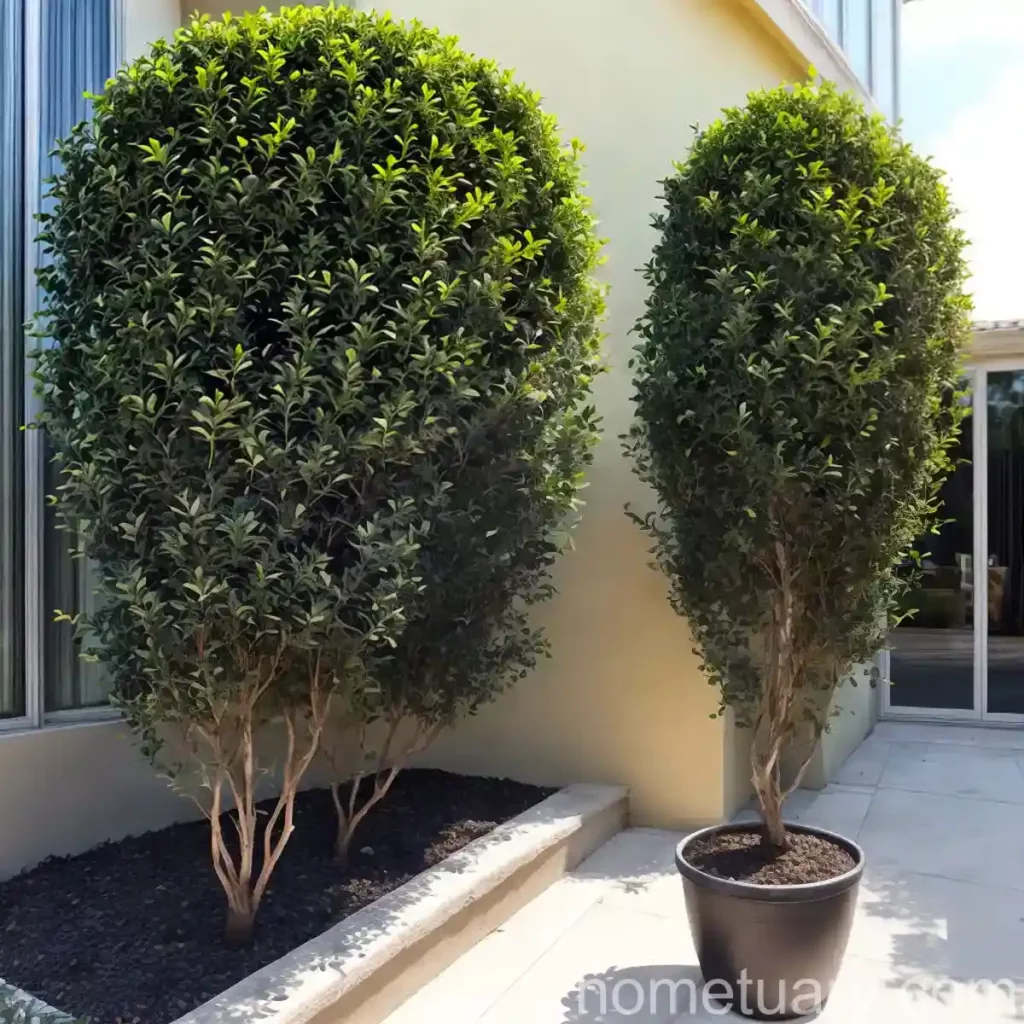A Comprehensive Guide to Glossy Privet (Ligustrum lucidum)
Glossy privet, scientifically known as Ligustrum lucidum, is a beautiful and versatile evergreen shrub that is valued for its glossy green leaves, white flowers, and black berries. As a plant scientist, I am excited to delve into the various aspects of this plant, including its culture, uses, care requirements, and much more. In this comprehensive guide, we will explore everything from cultivation and maintenance to the unique features, benefits, and potential uses of Ligustrum lucidum. Let’s embark on this enlightening journey to uncover the wonders of glossy privet and gain valuable insights into its characteristics and practical applications.
What is Plant: Glossy Privet (Ligustrum lucidum)?
Glossy privet, also known as Chinese privet, is a species of Ligustrum native to China and commonly cultivated as an ornamental plant in many parts of the world. It belongs to the Oleaceae family, which includes olive and lilac plants. This evergreen shrub is highly valued for its attractive foliage, rapid growth, and adaptability to various growing conditions. The glossy privet is characterized by its lustrous, dark green leaves, fragrant white flowers, and berry-like fruits, which add ornamental value to gardens, landscapes, and urban settings.
Key Takeaways – Glossy Privet (Ligustrum lucidum)
Before delving into the specifics of glossy privet, let’s highlight some key takeaways about this remarkable plant:
- Scientific Name: Ligustrum lucidum
- Common Names: Glossy privet, Chinese privet
- Family: Oleaceae
- Type: Evergreen shrub
- Notable Features: Glossy green leaves, white fragrant flowers, black berries
- Uses: Ornamental landscaping, hedges, privacy screens, urban gardening
- Growth Rate: Fast
- Growth Conditions: Adaptable, tolerant of various soils and climates
- Maintenance: Requires regular pruning and maintenance to control growth
Now, let’s explore the various aspects of glossy privet in detail, including its culture, uses, care requirements, and maintenance tips.
Culture
The culture of glossy privet encompasses its growth requirements, soil preferences, water and sunlight needs, as well as its overall adaptation to different environments. Understanding the culture of this plant is essential for ensuring its successful cultivation and optimal performance in various settings. Let’s delve into the specific cultural aspects of Ligustrum lucidum.
Water
Proper watering is crucial for the health and vitality of glossy privet plants. While this species is known for its adaptability to different moisture levels, it is important to establish a regular watering routine, especially during the establishment phase and periods of prolonged drought. Here are some key points to consider regarding the water requirements of Ligustrum lucidum:
- Establishment: Newly planted glossy privet shrubs require regular watering to promote root establishment and growth. Keep the soil consistently moist, but avoid waterlogging the root zone.
- Mature Plants: Once established, glossy privet plants are relatively drought-tolerant and can withstand moderate dry spells. However, it is advisable to provide supplemental irrigation during prolonged periods of drought to maintain healthy foliage and overall vitality.
Sunlight
Glossy privet thrives in full sun to partial shade, making it a versatile plant for various light conditions. When selecting a planting location for Ligustrum lucidum, consider the following sunlight requirements:
- Full Sun: In regions with mild climates, glossy privet benefits from receiving full sun for a significant portion of the day. Full sun exposure promotes robust growth, lush foliage, and abundant flowering.
- Partial Shade: In hot or arid climates, providing partial shade during the intense afternoon hours can help protect glossy privet plants from heat stress and excessive transpiration. Partial shade can also be beneficial in locations with exceptionally high temperatures or prolonged heatwaves.
Fertilizer
Proper fertilization is essential for supporting the growth, foliage development, and overall health of glossy privet plants. While Ligustrum lucidum is relatively adaptable to different soil conditions, it can benefit from regular fertilization to ensure optimal nutrition and vitality. Consider the following guidelines for fertilizing glossy privet:
- Timing: Apply a balanced fertilizer in early spring before the onset of new growth. A slow-release or granular fertilizer is ideal for providing long-lasting nutrients throughout the growing season.
- Application Rate: Follow the manufacturer’s recommendations for the application rate based on the size and age of the glossy privet plants. Avoid excessive fertilization, as this can lead to excessive vegetative growth and potential nutrient imbalances.
- Nutrient Balance: Look for a fertilizer with a balanced NPK ratio (nitrogen, phosphorus, potassium) to support overall plant health, root development, and flowering. Additionally, consider incorporating organic matter or compost into the soil to improve fertility and texture.
Soil
The soil preferences of glossy privet revolve around well-draining, slightly acidic to slightly alkaline soil with adequate fertility and structure. Understanding the soil requirements of Ligustrum lucidum is essential for establishing a conducive growing environment and maintaining healthy, vigorous plants. Here are some considerations for the soil preferences of glossy privet:
- Drainage: Ensure that the planting site has good drainage to prevent waterlogged conditions, which can lead to root rot and other moisture-related issues. Amending heavy clay soils with organic matter or perlite can improve drainage and aeration.
- pH Range: Glossy privet plants thrive in slightly acidic to slightly alkaline soil with a pH range of 6.0 to 7.5. Conduct a soil test to assess the pH levels and make necessary adjustments using lime to raise the pH or elemental sulfur to lower the pH, if needed.
- Fertility: Enrich the soil with organic matter, such as compost or well-rotted manure, to improve fertility and enhance the soil structure. Organic amendments also contribute to beneficial microbial activity and nutrient availability for the glossy privet plants.
Pruning
Proper pruning is essential for maintaining the desired shape, size, and overall appearance of glossy privet plants. Regular pruning also helps to control growth, promote branching, and rejuvenate older shrubs. Understanding the principles of pruning and the specific techniques for glossy privet is integral to achieving healthy, well-maintained plants. Let’s explore the key aspects of pruning Ligustrum lucidum:
- Timing: Perform major pruning during late winter or early spring before the onset of new growth. This timing allows the plants to recover and produce new shoots during the active growing season.
- Techniques: Use sharp, clean pruning tools to make precise cuts and avoid causing unnecessary damage to the plant. Remove dead, damaged, or diseased branches, and selectively prune to shape the plant and maintain the desired size.
- Size Control: Glossy privet can be pruned to form hedges, screens, or topiary shapes, depending on the desired landscaping design. Regular shearing or selective pruning can be employed to control the size and density of the plants.
- Thinning: Periodically thin out the interior branches to improve air circulation, reduce the risk of fungal diseases, and encourage the development of new growth throughout the plant.
Propagation
The propagation of glossy privet can be achieved through various methods, including seed propagation, stem cuttings, and division. Understanding the techniques and best practices for propagating Ligustrum lucidum is valuable for expanding plantings, rejuvenating older specimens, and creating new hedges or ornamental displays. Let’s explore the different propagation methods for glossy privet:
Stem Cuttings
Stem cuttings are one of the most common and reliable methods for propagating glossy privet. Follow these steps to propagate Ligustrum lucidum from stem cuttings:
- Selecting Cuttings: Choose healthy, non-flowering stems with several leaf nodes. Cut 4- to 6-inch sections of the stem using clean, sharp pruning shears.
- Preparation: Remove the lower leaves from the cuttings, leaving 2-3 leaves at the top. Dip the cut end in a rooting hormone to encourage root development.
- Planting: Insert the cuttings into a well-draining propagation medium, such as perlite or a mix of peat and sand. Ensure that the nodes are below the soil surface.
- Rooting: Place the cuttings in a warm, humid environment with indirect light. Maintain consistent moisture and monitor the development of roots over the following weeks.
Seed Propagation
While glossy privet can be propagated from seeds, this method is less commonly used due to the potential variability in seed germination and the time required for the plants to reach maturity. If you choose to propagate Ligustrum lucidum from seeds, follow these general steps:
- Seed Collection: Collect ripe berries from the plant, and extract the seeds from the fleshy fruit. Clean the seeds and allow them to air dry for several days.
- Sowing: Sow the seeds in a well-draining potting mix at a shallow depth, and lightly cover them with additional soil. Water the seeds gently to settle the soil.
- Germination: Place the seed trays in a warm, bright location, and maintain consistent moisture. Be patient, as seed germination may take several weeks to several months.
Division
Division can be employed for propagating glossy privet by separating mature plants into smaller sections, each with its own root system. This method is particularly useful for rejuvenating overgrown shrubs and expanding the planting area. Follow these steps to divide and propagate Ligustrum lucidum:
- Established Plants: Choose well-established glossy privet plants with healthy root systems and multiple shoots.
- Division: Carefully dig up the entire plant and divide the root ball into smaller sections using a sharp spade or pruning saw.
- Planting: Replant the divided sections in prepared soil, and water them thoroughly. Provide appropriate care to ensure successful establishment and growth.
Container Popularity
Glossy privet is well-suited for container gardening, offering a versatile and compact option for urban landscapes, patios, and small outdoor spaces. The popularity of Ligustrum lucidum in containers is attributed to its adaptability, ornamental value, and tolerance of container growth. Here are some key points regarding the container popularity of glossy privet:
- Suitable Varieties: Select compact or dwarf varieties of glossy privet for container cultivation, as they are well-suited to confined growing spaces and can be shaped or pruned to maintain an attractive form.
- Urban Gardening: Glossy privet plants thrive in urban environments, where they can be used to create privacy screens, decorative accents, or greenery in confined areas. Container cultivation allows for easy mobility and placement in strategic locations.
- Design Flexibility: Incorporate glossy privet into container garden designs, mixed plantings, or thematic displays. The attractive foliage, white flowers, and black berries add visual interest and create a dynamic focal point.
Container Maintenance
Successfully growing glossy privet in containers requires attentive maintenance and care to ensure the health and vigor of the plants. Understanding the specific maintenance requirements for Ligustrum lucidum in containers is essential for achieving optimal growth and aesthetic appeal. Consider the following maintenance tips for container-grown glossy privet:
- Watering: Monitor the moisture levels in the container soil and water the plants as needed to prevent drought stress. Container-grown glossy privet may require more frequent watering compared to plants in the ground, especially during hot, dry periods.
- Fertilization: Apply a balanced, slow-release fertilizer to container-grown glossy privet in spring to provide essential nutrients for sustained growth and flowering. Follow the recommended application rates and avoid overfertilization, which can lead to excessive vegetative growth.
- Pruning: Regularly prune and shape container-grown glossy privet to maintain the desired size and form. Container plants may require more frequent pruning to control growth and prevent overcrowding within limited growing space.
Uses
The uses of glossy privet encompass its diverse applications in landscaping, horticulture, traditional medicine, and ornamental gardening. Understanding the versatility and practical uses of Ligustrum lucidum is crucial for appreciating its value and potential contributions in various contexts. Let’s explore the multifaceted uses of glossy privet:
Landscaping
Glossy privet is widely utilized in landscaping and horticulture for its ornamental foliage, fragrant flowers, and visual appeal. Here are some common landscaping uses of Ligustrum lucidum:
- Hedges: Glossy privet is a popular choice for creating formal or informal hedges due to its dense growth habit, rapid growth, and tolerance of shearing. It can be shaped into neat, uniform hedges to define boundaries, create privacy screens, or delineate garden spaces.
- Shrub Borders: Incorporate glossy privet into mixed shrub borders or foundation plantings to add texture, height variation, and evergreen interest. The glossy foliage provides a vibrant backdrop for other plants and seasonal blooms.
- Topiary: With its vigorous growth and ability to withstand regular pruning, glossy privet can be shaped into whimsical topiary forms, such as spheres, cones, or spirals, adding a touch of artistry to the landscape.
- Container Plantings: Utilize compact or dwarf varieties of glossy privet in container plantings to enhance outdoor spaces, patios, and balconies. Container-grown glossy privet can be moved or rearranged to create visual impact and dynamic arrangements.
Traditional Medicine
Beyond its ornamental uses, glossy privet has a history of traditional use in herbal medicine. Various parts of the plant, including the leaves, fruit, and roots, have been employed for their purported therapeutic properties. While the traditional uses of Ligustrum lucidum in herbal medicine are beyond the scope of this guide, it is important to acknowledge its cultural and historical significance in traditional healing practices.
Wildlife Habitat
Glossy privet serves as a valuable resource for wildlife, providing shelter, food, and nesting sites for a variety of animals, including birds, insects, and small mammals. The dense foliage and berries of Ligustrum lucidum attract birds that feed on the fruit, while also creating a hospitable environment for nesting and roosting. Additionally, the flowers of glossy privet attract pollinators, such as bees and butterflies, contributing to the biodiversity and ecological value of the plant.
Urban Gardening
In urban and suburban settings, glossy privet offers an adaptable and aesthetically pleasing option for gardening in limited spaces. Its tolerance of pollution, compact growth habit, and ornamental features make it well-suited for urban gardening applications, such as:
- Street Plantings: Use glossy privet to beautify streetscapes, urban avenues, and traffic islands, where its glossy foliage and spring blossoms enhance the visual appeal of public spaces.
- Green Screens: Create green screens or living barriers using glossy privet to provide privacy, reduce noise, and delineate outdoor areas in urban settings. Well-maintained hedges of Ligustrum lucidum can serve as effective privacy screens for residential and commercial properties.
- Rooftop Gardens: Incorporate container-grown glossy privet into rooftop gardens, terrace plantings, and elevated landscapes to introduce greenery, mitigate heat, and enhance the livability of urban environments.
Common Diseases
Like all plants, glossy privet is susceptible to certain diseases that can affect its growth, appearance, and overall health. Understanding the common diseases that may afflict Ligustrum lucidum is crucial for implementing preventive measures and timely interventions to safeguard the plants. Let’s explore some of the common diseases that can impact glossy privet:
Powdery Mildew (Erysiphe spp.)
Powdery mildew is a fungal disease that appears as a white, powdery growth on the leaves, stems, and flower buds of plants. It thrives in high humidity and moderate temperatures, often manifesting in late spring to early summer. To manage powdery mildew on glossy privet:
- Cultural Practices: Promote good air circulation around the plants through proper spacing and selective pruning. Avoid overhead watering and reduce excess moisture on foliage.
- Fungicidal Treatments: Apply fungicidal sprays containing sulfur, neem oil, or potassium bicarbonate to suppress powdery mildew. Follow the manufacturer’s instructions for proper application and safety precautions.
Anthracnose (Colletotrichum spp.)
Anthracnose is a fungal disease that causes dark, sunken lesions on the leaves, stems, and fruits of affected plants. It thrives in moist conditions and can lead to defoliation and reduced plant vigor. To manage anthracnose on glossy privet:
- Sanitation: Remove and dispose of infected plant debris to reduce the spread of the disease. Avoid overhead irrigation and minimize splashing of water on the foliage.
- Fungicidal Control: Apply fungicidal sprays containing copper-based compounds or chlorothalonil to protect the plants from anthracnose. Begin treatments preventively during periods of high humidity and rainfall.
Root Rot (Phytophthora spp.)
Root rot is a common fungal disease that affects the root system of plants, leading to wilting, yellowing foliage, and overall decline. Excessive soil moisture and poor drainage can contribute to the development of root rot. To manage root rot on glossy privet:
- Improving Drainage: Ensure that the planting site has adequate drainage to prevent waterlogging and create a healthy root environment. Amending heavy soils with perlite or organic matter can improve drainage.
- Water Management: Avoid overwatering and maintain moderate soil moisture levels to prevent the onset of root rot. Allow the soil to partially dry between watering sessions.
Disease Diagnosis
Diagnosing diseases in glossy privet involves careful observation of symptoms, environmental conditions, and potential stress factors that may contribute to the development of diseases. When inspecting the plants, consider the following steps for accurate disease diagnosis:
- Symptom Recognition: Identify the specific symptoms exhibited by the plants, such as leaf spots, powdery growth, leaf yellowing, wilting, or dieback. Look for any patterns or associations between the symptoms and the affected plant parts.
- Environmental Assessment: Evaluate the growing conditions, including moisture levels, light exposure, soil quality, and air circulation. Assess any recent weather events or environmental stressors that may impact plant health.
- Pathogen Identification: Consult with local extension services, botanical gardens, or diagnostic laboratories to identify potential pathogens responsible for the observed symptoms. Proper identification is essential for implementing targeted management strategies.
Common Pests
In addition to diseases, glossy privet may be susceptible to certain insect pests that can affect its foliage, flowers, and overall growth. Understanding the common pests that may infest Ligustrum lucidum is essential for implementing integrated pest management strategies to protect the plants. Let’s explore some of the common pests that can impact glossy privet:
Aphids
Aphids are small, soft-bodied insects that feed on the sap of plants, causing distorted growth, yellowing leaves, and honeydew secretion. They often congregate on the tender new growth and undersides of leaves. To manage aphids on glossy privet:
- Natural Predators: Encourage natural predators, such as ladybugs, lacewings, and parasitic wasps, which feed on















